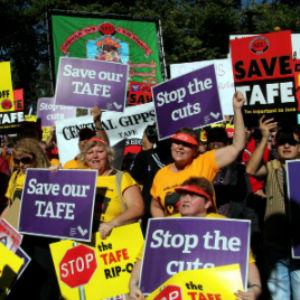State Government budget cuts to The Technical and Further Education sector are widespread. In NSW the cuts to TAFE are $80 million, in QLD $78.8 million and in Victoria, the most dramatically affected, the cuts to a service providing for almost 500,000 students are $300 million with the loss of 2000 teaching staff.
Such budget-slashing will dramatically lessen the opportunities for professional development for young, emerging and established artists – whether engaged in film, digital media, animation and games development, performing arts, fine arts and design, literature and publishing, or cross media activity.
The TAFE cuts will also profoundly and detrimentally affect the general public’s engagement with the arts. Half a million students in Victoria have enrolled for, or have been studying, subjects about which they wish to know more… either for a vocational purpose or general interest.
In another era “The Tech College” was rightly or wrongly perceived as “working class education” for potential tradesmen with the odd bit or two of collateral benefit for those craftspeople who could study technical things like glass-blowing, furniture making, ceramics or metal work.
The contemporary TAFE reality, driven by demand, is that courses range from film-making and animation to sculpture and ceramics, from music creation and instrument-making to professional writing, from acting, directing and stage management to industrial and fashion design and from business skills to contemporary promotion and communication.
It’s also difficult, given the convergence of art forms with vocational occupations, to think of a TAFE “technical” area that isn’t affected by the artistic impulse. For example TAFE-educated IT specialists create art everyday without even thinking about it. Designers, the invisible visual artists most affecting our daily lives along with similarly TAFE educated public relations and advertising “creatives” would be as unemployable as dinosaurs if they were not strongly influenced by, amongst other things, the “Fine Arts”. (An area which The NSW government announced two weeks ago would be specifically targeted if not demolished by its TAFE cuts.)
The TAFE sector with its emphasis on practical skills and technical training has often been seen as alternative to University. Universities, collectively and in general, tend to possess a particular culture and though within that culture there is a diversity of approaches, the objective is knowledge soundly constructed on a theoretical basis. But many highly talented artists across the genres think divergently and see the world very differently to those whose own talents may be ideally suited for University education. This is not to suggest that academia and academics are not creative but the fact is that many gifted and creative young artists do not make it into the University system, especially where admission is based on a TER score. Some universities, to counter-act this, utilize a talent based /interview admission system, and studio based/performance assessments but typically the textual requirements still loom large. The subject of “learning difficulties” or “dyslexia” is a delicate one even, or especially, for those with experience in the multiple ways in which different brains work. An unjustified stigma is still attached to many vastly different forms of perception and information retrieval. One has to ask the simple question of why designers, animators, sculptors, painters, musicians, actors, etc. are what they are. Their talents are very often not at all dependent on textual or theoretical analysis, and for them a practical and technical training offers a renewed sense of worth.
During my years as the Director/CEO of The Victorian College of The Arts we maintained a talent-based system of entry. The high demand for few places meant that it was highly competitive. Unsuccessful but determined candidates were frequently advised to consider relevant TAFE courses to enhance their skills, and to develop a more competitive portfolio. And many succeeded in gaining a place after such a course of action. This option has been an important one generally for young people that have clear ambitions, or fallen through the educational cracks and want to reengage with education.
TAFE in its own right offers sound training and education but also can offer articulated entry to universities. Why state governments are taking action to deprive young people of options and hope is astounding. They are our future, our country’s success is invested in how we provide for them. Our Asian neighbours understand this, education and training are the key to personal and national advancement. And for a country whose cultural confidence is relatively recent, and whose maturation has been entwined with it, it is even more astonishing, especially when the cultural industries represent one of the great growth sectors in our economy.





